
Concept explainers
(a)
Interpretation:
The structure of the given compound has to be drawn.
Concept Introduction:
IUPAC naming of
- 1) The simplest aromatic
carboxylic acid is benzoic acid. - 2) Aromatic carboxylic acids are generally derivatives of benzoic acid.
- 3) The suffix –oic acid is used in IUPAC system and the suffix –ic acid is used in common system and is attached to the appropriate prefix.
- 4) The phenyl group is treated as substituent and the name is obtained from the appropriate alkanoic acid parent chain.
(a)
Answer to Problem 14.3PP
The structure of the given compound is,
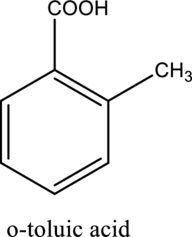
Explanation of Solution
The given compound is
The structure of the given compound is,
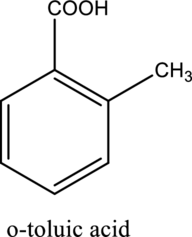
This compound is
(b)
Interpretation:
The structure of the given compound has to be drawn.
Concept Introduction:
IUPAC naming of Aromatic Carboxylic acids
- 1) The simplest aromatic carboxylic acid is benzoic acid.
- 2) Aromatic carboxylic acids are generally derivatives of benzoic acid.
- 3) The suffix –oic acid is used in IUPAC system and the suffix –ic acid is used in common system and is attached to the appropriate prefix.
- 4) The phenyl group is treated as substituent and the name is obtained from the appropriate alkanoic acid parent chain.
(b)
Answer to Problem 14.3PP
The structure of the given compound is,

Explanation of Solution
The given compound is
The substituent
The structure of the given compound is,
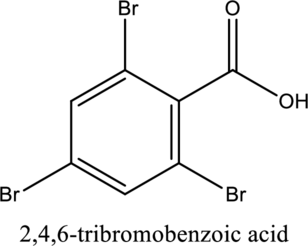
This compound is
(c)
Interpretation:
The structure of the given compound has to be drawn.
Concept Introduction:
IUPAC naming of Aromatic Carboxylic acids
- 1) The simplest aromatic carboxylic acid is benzoic acid.
- 2) Aromatic carboxylic acids are generally derivatives of benzoic acid.
- 3) The suffix –oic acid is used in IUPAC system and the suffix –ic acid is used in common system and is attached to the appropriate prefix.
- 4) The phenyl group is treated as substituent and the name is obtained from the appropriate alkanoic acid parent chain.
(c)
Answer to Problem 14.3PP
The structure of the given compound is,
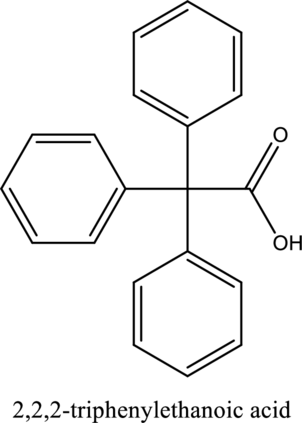
Explanation of Solution
The given compound is
The substituent phenyl is bonded to carbon
The structure of the given compound is,
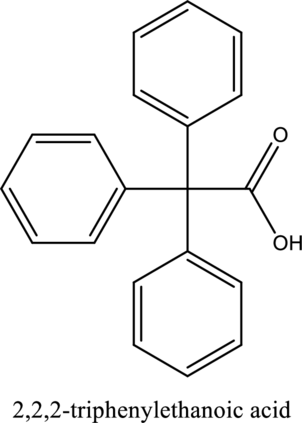
This compound is
(d)
Interpretation:
The structure of the given compound has to be drawn.
Concept Introduction:
IUPAC naming of Aromatic Carboxylic acids
- 1) The simplest aromatic carboxylic acid is benzoic acid.
- 2) Aromatic carboxylic acids are generally derivatives of benzoic acid.
- 3) The suffix –oic acid is used in IUPAC system and the suffix –ic acid is used in common system and is attached to the appropriate prefix.
- 4) The phenyl group is treated as substituent and the name is obtained from the appropriate alkanoic acid parent chain.
(d)
Answer to Problem 14.3PP
The structure of the given compound is,
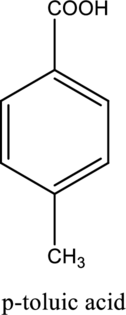
Explanation of Solution
The given compound is
The structure of the given compound is,
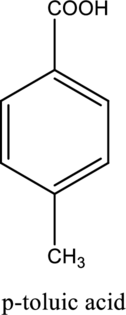
This compound is
(e)
Interpretation:
The structure of the given compound has to be drawn.
Concept Introduction:
IUPAC naming of Aromatic Carboxylic acids
- 1) The simplest aromatic carboxylic acid is benzoic acid.
- 2) Aromatic carboxylic acids are generally derivatives of benzoic acid.
- 3) The suffix –oic acid is used in IUPAC system and the suffix –ic acid is used in common system and is attached to the appropriate prefix.
- 4) The phenyl group is treated as substituent and the name is obtained from the appropriate alkanoic acid parent chain.
(e)
Answer to Problem 14.3PP
The structure of the given compound is,
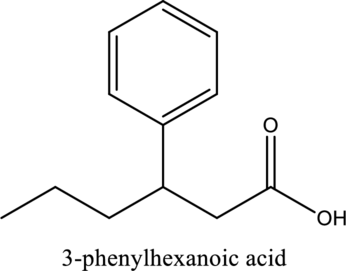
Explanation of Solution
The given compound is
The substituent phenyl is bonded to carbon
The structure of the given compound is,
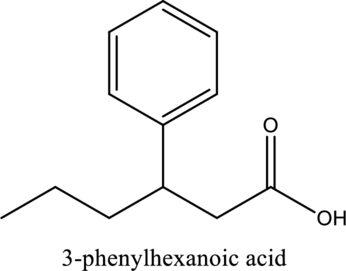
(f)
Interpretation:
The structure of the given compound has to be drawn.
Concept Introduction:
IUPAC naming of Aromatic Carboxylic acids
- 1) The simplest aromatic carboxylic acid is benzoic acid.
- 2) Aromatic carboxylic acids are generally derivatives of benzoic acid.
- 3) The suffix –oic acid is used in IUPAC system and the suffix –ic acid is used in common system and is attached to the appropriate prefix.
- 4) The phenyl group is treated as substituent and the name is obtained from the appropriate alkanoic acid parent chain.
(f)
Answer to Problem 14.3PP
The structure of the given compound is,
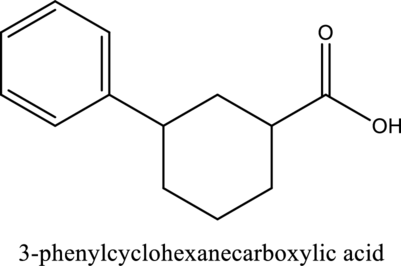
Explanation of Solution
The given compound is
The substituent phenyl is bonded to carbon
The structure of the given compound is,
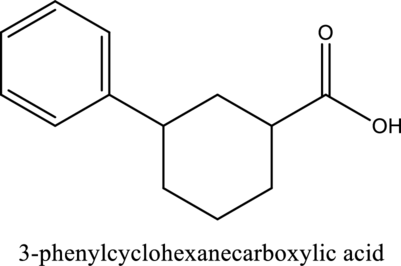
Want to see more full solutions like this?
Chapter 14 Solutions
GENERAL,ORGANIC,+BIOCHEMISTRY(LL)-PKG
- Which of the following metals is the only one with all of its bands completely full? Group of answer choices K Na Ca Alarrow_forward2. Specify the solvent and reagent(s) required to carry out each of the following FGI. If two reagent sets must be used for the FGI, specify the solvent and reagent(s) for each reagent set. If a reaction cannot be carried out with reagents (sets) class, write NP (not possible) in the solvent box for reagent set #1. Use the letter abbreviation for each solvent; use a number abbreviation for reagent(s). Solvents: CH2Cl2 (A); Reagents: H₂O (B); CH3CO₂H (D) NaHCO3 (4); Hg(OAc)2 (5); HBr (1); R₂BH (6); H2SO4 (2); CH3OH (C); Br₂ (3); H₂O₂ / HO- (7); NaBH4 (8) Reagent Set #1 Reagent Set #2 FGI OH - α-α Br + enant Solvent Reagent(s) Solvent Reagent(s)arrow_forwardBased on concepts from Lecture 3-5, which of the following ionic compounds should be most soluble in water? Group of answer choices MgO BeO CaO BaOarrow_forward
- From an energy standpoint, which two process - in the correct order - are involved in the dissolving of an ionic compound crystal? Group of answer choices Water coordination to the ions followed by sublimation into the gas phase Sublimation of the crystal into gas-phase ions followed by water coordination to the ions Ion dissociation from the crystal followed by water coordination to the ions Water coordination to the ions followed by ion dissociation from the crystalarrow_forwardFor which Group 2 metal (M), is this process the most exothermic? M2+(g) + O2−(g) + CO2(g) → MO(s) + CO2(g) Group of answer choices M = Sr M = Mg M = Ca M = Baarrow_forward2. Specify the solvent and reagent(s) required to carry out each of the following FGI. If two reagent sets must be used for the FGI, specify the solvent and reagent(s) for each reagent set. If a reaction cannot be carried out with reagents (sets) class, write NP (not possible) in the solvent box for reagent set #1. Use the letter abbreviation for each solvent; use a number abbreviation for reagent(s). Solvents: CH2Cl2 (A); H₂O (B); Reagents: HBr (1); H2SO4 (2); CH3OH (C); Br₂ (3); CH3CO₂H (D) NaHCO3 (4); Hg(OAc)2 (5); R₂BH (6); H₂O₂ / HO- (7); NaBH4 (8) Reagent Set #1 Reagent Set #2 FGI Solvent Reagent(s) Solvent Reagent(s) HO OHarrow_forward
- For which of the following ionic compounds would you expect the smallest difference between its theoretical and experimental lattice enthalpies? (You may assume these all have the same unit cell structure.) Electronegativities: Ca (1.0), Fe (1.8), Mg (1.2), O (3.5), S (2.5), Zn (1.6) Group of answer choices ZnO MgS CaO FeSarrow_forwardIn the Born-Haber cycle for KCl crystal formation, what enthalpy component must be divided by two? Group of answer choices KCl(s) enthalpy of formation Ionization energy for K(g) K(s) sublimation enthalpy Cl2 bond dissociation enthalpyarrow_forward2. Specify the solvent and reagent(s) required to carry out each of the following FGI. If two reagent sets must be used for the FGI, specify the solvent and reagent(s) for each reagent set. If a reaction cannot be carried out with reagents (sets) class, write NP (not possible) in the solvent box for reagent set #1. Use the letter abbreviation for each solvent; use a number abbreviation for reagent(s). Solvents: CH2Cl2 (A); H₂O (B); Reagents: HBr (1); R₂BH (6); H2SO4 (2); CH3OH (C); Br₂ (3); CH3CO₂H (D) NaHCO3 (4); Hg(OAc)2 (5); H₂O₂ / HO (7); NaBH4 (8) Reagent Set #1 Reagent Set #2 FGI хот Br Solvent Reagent(s) Solvent Reagent(s)arrow_forward
- What is the correct chemical equation for the lattice formation reaction for CaBr2? Group of answer choices Ca2+(g) + 2 Br−(g) → CaBr2(s) ½ Ca2+(g) + Br−(g) → ½ CaBr2(s) Ca(s) + Br2(l) → CaBr2(s) Ca(s) + 2 Br−(g) → CaBr2(s)arrow_forwardPLEASE ANSWER THE QUESTION!!!arrow_forward3. SYNTHESIS. Propose a sequence of synthetic steps (FGI) that convert the starting material (SM) into the Target molecule. For each FGI in your proposed synthesis, specify the reagents / conditions, and draw the product(s) of that FGI. DO NOT INCLUDE the FGI mxn in the answer you submit. If an FGI requires two reagent sets, specify the order in which the reagent sets are added, e.g., i) Hg(OAc)2 / H₂O; ii) NaBH4/MeOH. Indicate the stereochemistry (if any) of the products of each FGI. FGI 1. Me Starting Material Source of all carbons in the Target molecule (can use multiple copies) Me Me Target molecule + enantiomerarrow_forward
 ChemistryChemistryISBN:9781305957404Author:Steven S. Zumdahl, Susan A. Zumdahl, Donald J. DeCostePublisher:Cengage Learning
ChemistryChemistryISBN:9781305957404Author:Steven S. Zumdahl, Susan A. Zumdahl, Donald J. DeCostePublisher:Cengage Learning ChemistryChemistryISBN:9781259911156Author:Raymond Chang Dr., Jason Overby ProfessorPublisher:McGraw-Hill Education
ChemistryChemistryISBN:9781259911156Author:Raymond Chang Dr., Jason Overby ProfessorPublisher:McGraw-Hill Education Principles of Instrumental AnalysisChemistryISBN:9781305577213Author:Douglas A. Skoog, F. James Holler, Stanley R. CrouchPublisher:Cengage Learning
Principles of Instrumental AnalysisChemistryISBN:9781305577213Author:Douglas A. Skoog, F. James Holler, Stanley R. CrouchPublisher:Cengage Learning Organic ChemistryChemistryISBN:9780078021558Author:Janice Gorzynski Smith Dr.Publisher:McGraw-Hill Education
Organic ChemistryChemistryISBN:9780078021558Author:Janice Gorzynski Smith Dr.Publisher:McGraw-Hill Education Chemistry: Principles and ReactionsChemistryISBN:9781305079373Author:William L. Masterton, Cecile N. HurleyPublisher:Cengage Learning
Chemistry: Principles and ReactionsChemistryISBN:9781305079373Author:William L. Masterton, Cecile N. HurleyPublisher:Cengage Learning Elementary Principles of Chemical Processes, Bind...ChemistryISBN:9781118431221Author:Richard M. Felder, Ronald W. Rousseau, Lisa G. BullardPublisher:WILEY
Elementary Principles of Chemical Processes, Bind...ChemistryISBN:9781118431221Author:Richard M. Felder, Ronald W. Rousseau, Lisa G. BullardPublisher:WILEY





